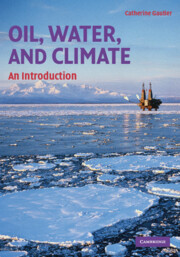Book contents
- Frontmatter
- Contents
- Foreword
- Introduction
- 1 Overview
- 2 Carbon Dioxide Emissions, Global Warming, and Water Resources
- 3 Population, Environmental Impacts, and Climate Change
- 4 Carbon Cycle and the Human Impact
- 5 Peak Oil, Energy, Water, and Climate
- 6 Oil Consumption and CO2 Emissions from Transportation
- 7 Oil, Economy, Power, and Conflicts
- 8 Energy Alternatives and Their Connection to Water and Climate
- 9 The Water Cycle and Global Warming
- 10 Fresh Water Availability, Sanitation Deficit, and Water Usage: Connection to Energy and Global Warming
- 11 Rivers, Lakes, Aquifers, and Dams: Relation to Energy and Climate
- 12 Water Contamination, Energy, and Climate
- 13 Geopolitics of Water and the International Situation
- 14 Water Alternatives
- 15 Global Climate Change: Observations, Modeling, and Predictions
- 16 Energy and Water Challenges and Solutions in a Changing Climate Framework: Commonality, Differences, and Connections
- References
- Index
6 - Oil Consumption and CO2 Emissions from Transportation
Published online by Cambridge University Press: 05 September 2012
- Frontmatter
- Contents
- Foreword
- Introduction
- 1 Overview
- 2 Carbon Dioxide Emissions, Global Warming, and Water Resources
- 3 Population, Environmental Impacts, and Climate Change
- 4 Carbon Cycle and the Human Impact
- 5 Peak Oil, Energy, Water, and Climate
- 6 Oil Consumption and CO2 Emissions from Transportation
- 7 Oil, Economy, Power, and Conflicts
- 8 Energy Alternatives and Their Connection to Water and Climate
- 9 The Water Cycle and Global Warming
- 10 Fresh Water Availability, Sanitation Deficit, and Water Usage: Connection to Energy and Global Warming
- 11 Rivers, Lakes, Aquifers, and Dams: Relation to Energy and Climate
- 12 Water Contamination, Energy, and Climate
- 13 Geopolitics of Water and the International Situation
- 14 Water Alternatives
- 15 Global Climate Change: Observations, Modeling, and Predictions
- 16 Energy and Water Challenges and Solutions in a Changing Climate Framework: Commonality, Differences, and Connections
- References
- Index
Summary
Transportation accounts for more than half of the world's oil consumption, relying on oil for virtually all of its fuel. Although the majority of oil consumption is in North America, China's fast-growing automobile industry is also becoming dependent on it. Several ways exist to address transportation consumption: technology-based approaches including clean burning and renewable fuels, fuel economy improvements, and stricter fuel economy standards and emissions regulations.
Introduction
Developed countries that make up the Organization for Economic Cooperation and Development (OECD) account for almost two-thirds of the worldwide oil consumption. Although their oil demand has been steadily increasing, their rate of increase has been overtaken by that of developing countries, and this trend is expected to continue over the foreseeable future.
The predicted growth in oil demand – a total consumption increase of 40 million barrels per day between 2004 and 2030 (based on different scenarios and thus containing some uncertainties) – is expected to be largely the result of increases in the transportation sector, which are projected to consume about two-thirds of the total, and a large part of that predicted expansion will be originating in the developing countries (EIA, 2006b).
Based on per capita consumption level, the present oil consumption of Canada and the United States stands apart from the rest of the world because of the massive energy use by their transportation sectors. However, although most developing nations around the globe have thus far been using oil largely for heating and generating power, the situation is slowly changing.
- Type
- Chapter
- Information
- Oil, Water, and ClimateAn Introduction, pp. 100 - 122Publisher: Cambridge University PressPrint publication year: 2008



